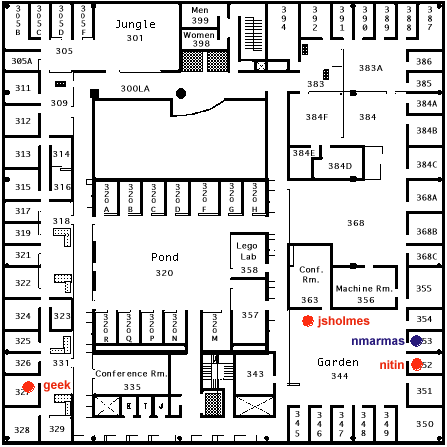
We inhabit a physical world yet must participate within an electronic and distributed community. RadioSpace is an attempt to provide awareness of people and their presence in the physical world. Throughout the day as people move through physical space, others can sense their location and state in the virtual environment, using a combination of visual and auditory cues.
We live in a world in which information overload is part of our daily life. Many of us receive large quantities of email or voice mail messages, yet many of these messages are relevant only in a particlular context. RadioSpace is an attempt to provide just-in-time context-related messaging in the work environment.
The RadioSpace server (also known as the Position Server) creates a ubiquitous information access scheme and communications medium. IR sensors are located in the passage ways of the work area, so nomadic users with wearable computers can transmit their physical location to the server. The server can then send the user messages related to his present physical context. The server maintains a history of user interaction and movement in space and time.
RadioSpace provides a robust communications mechanism for
nomadic users and a high degree of timely and context-aware information delivery.
Messages can be sent to any object in the system, whether it be another user,
place, or group of users or places.
For example, if a user has planned a meeting and is running late, he can send a
message such as 'start without me' to the conference room. This message
will be delivered only to those entering the conference room, who have been
scheduled for the meeting.
Such a message is relevant only to a certain group of people at a particular place
and for a certain period of time.

The web-based dynamic map client showing the physical location of users
The client username appears in blue whereas other users appear in orange.
A user can also track one or more other users, such that their activity is
continuously conveyed back to him over a certain period of time.
Privacy is not an issue since the level of privacy for any
information is specified on the client side. Also, the user has the option of simply not
connecting to the server. No non-publicly available information is made known in that
case.
The protocol used to communicate with the server is very general and allows for many
clients. Two such clients in progress are a web-based dynamic map client and the nomadic
client on a wearable computer (see related project
Nomadic Radio).
The clients can be used to find out where people are, send messages to users or
rooms, watch patterns of movement, etc. Other potential clients include telephone-based
clients, telnet clients, email clients, and even alphanumeric pager clients.